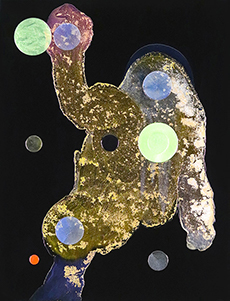
Part of a series exploring apophenic structure and reflective resonance.
A reading of Phaëthon and the structures beneath appearance.
Phaethon began as a problem of structure, not as an illustration of a myth. I built a dense, molten form across a black field and set coloured orbs around it to test how far I could stretch a balance between cohesion and collapse. Small shifts in light or position change how that balance reads.
The title came afterwards. Only after the painting had been finished and put aside for a while did I recognise in it the arc of the Phaethon story: an ascent that tips into loss of control. I did not set out to paint chariots or falling bodies. The myth names a dynamic I saw emerging in the completed work.
For me the piece is less a picture of an event than a situation in which order never fully settles. The orbs and the central mass keep slipping in and out of alignment, so that what feels coherent in one moment becomes unstable in the next. That edge, where a hidden system is strongly felt but never fully given, is where the work lives.